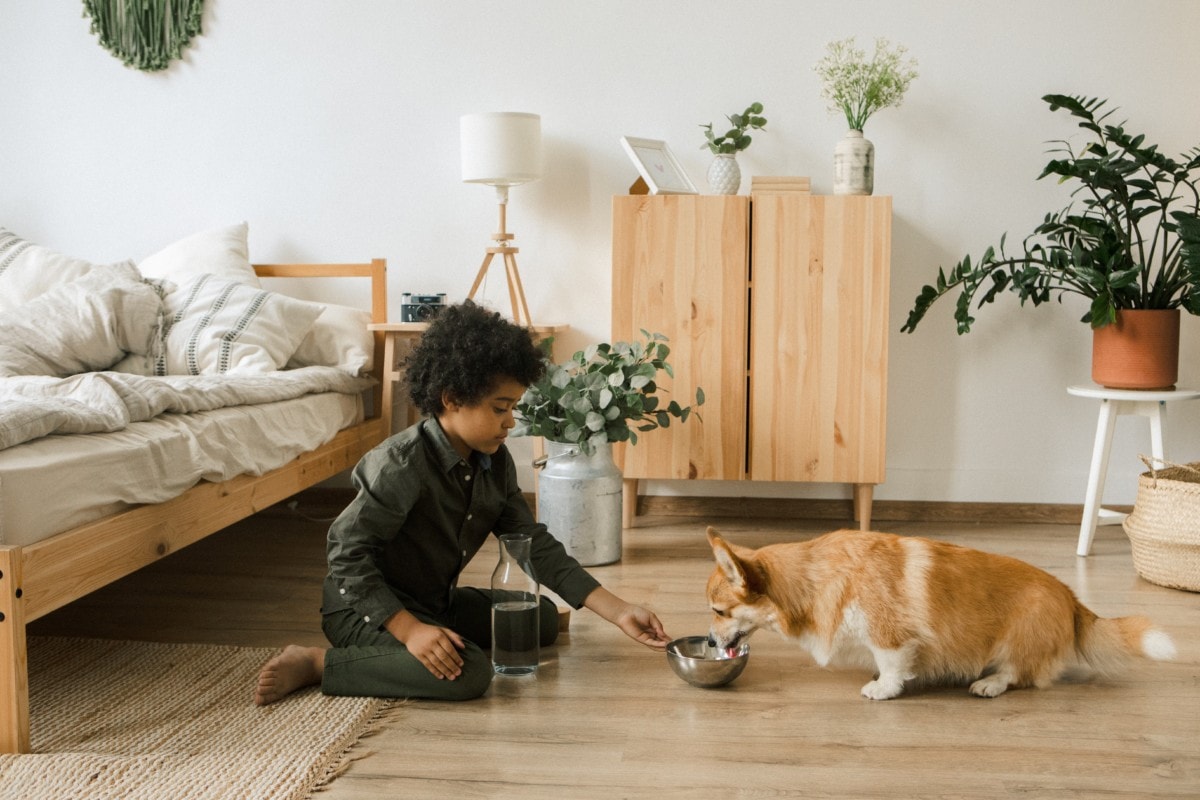Adopting a shelter pet is an exciting and fulfilling experience. Not only will you be helping an animal in need of a loving home, you’ll be gaining a new family member. However, it’s important to pet-proof your home, get their space set up with the essentials, and do a little research before bringing home a rescue pet.
With Adopt a Shelter Pet Day just around the corner, we reached out to experts all across the country – from San Francisco, CA to Houston, TX (and even St. Catherines, ON) – for their best advice to help you prepare your home for your new pet. Here’s how to make the transition from shelter to forever home as seamless as possible for your new furry friend:

First thing’s first: pet-proof your home
Store away hazardous household items
Never underestimate your pet’s abilities. Newly adopted pets will want to explore their new surroundings, and they can get into a lot of trouble quickly. Chemicals and human food can be very harmful if consumed. You can reduce exposure to harmful household items by keeping counters free of food, medications, lotions, etc., and closing trash cans and toilet seats. You should also be mindful of wires, clothing items, and houseplants. Doing your homework ahead of time will help you prepare for a successful homecoming. – Mt. Pleasant Animal Shelter
Tidy up your home
A tidy home is a safe and happy home when welcoming a new furry friend. Pets may chew on household items like shoes and cords, so keeping these out of reach ensures the safety of Fido and your favorite pair of sneakers. Every pet is different, so also consider if your home and lifestyle match the needs of your future companion. – Friends of Upland Animal Shelter
Properly pet-proof your backyard
Make sure your yard is secured and that there are no weak points in the fence. We recommend that you don’t use chain link fencing and that your fence is at least 6ft tall. If you have a pool, make sure your dog not only knows how to swim, but also knows their way out of the pool. For extra safety measures, make sure to purchase a pool fence before bringing home your animal. – Animal Friends of the Valleys

Don’t forget about your kitchen
Be sure to do your research to find out which foods are toxic for your new pet. To keep curious pets from picking up extra tidbits on the floor while you’re cooking, try installing a door or gate to keep them from wandering into your kitchen.
I’ve seen too many social media posts of a sick dog that has been undiagnosed by the owner’s vet or that are waiting for test results. All I can think of is how often we give in to those big, sad eyes begging for whatever we may be eating that often can be toxic to our pets. Be sure the treat you give your dog or cat is one that is specifically made for them. – Help Shelter Pets
Keep fragile or valuable items out of paw’s reach
Cats can jump. That vase of flowers you think is out of reach on the kitchen table actually isn’t. Consider keeping fragile, valuable, or potentially harmful items (like houseplants that are toxic to cats) on top of a high dresser, bookcase, or in an enclosure of some kind to protect your possessions and your feline friend. – Humane Action Pittsburgh
Accidents can happen, so consider hardwood floors
To make bathroom accidents easier to clean up, try keeping your pet in a room with hardwood floors – especially the first few days after welcoming them into your home. It can take them a while to get potty training down, and those “oops” moments are much easier to clean on hardwood rather than carpet. – Dog Tired Adventures
Avoid using certain fertilizers, soil additives, and pesticides
Fertilizers that contain bone meal or blood meal contain a lot of iron and feather meal which can be dangerous to dogs. Also, soil additives, pesticides, and insecticides that contain organophosphates can be life-threatening – even in small amounts. – Veterinary Emergency Group

Create a safe zone for your new pet to unwind
Make sure your home is a relaxing environment
When creating a room in your home for your new pet, make sure it’s in a suitable location. If there’s a particular room or area your pet seems drawn to, start there. Otherwise, you can pick a low-traffic location in your home to set up a relaxing environment.
While bringing home a new family member is very exciting, remember it’s also very nerve-wracking for your new pet: new home, new smells, new people, sometimes new brothers or sisters. Give them time and space to adjust. – Pets Alive Niagara
Designate a “safe haven” area for your pet
Did you know dogs are den animals? Dogs prefer a safe space that is just big enough for them to feel secure. Bringing your new pet home for the first time can often be an overwhelming transition, and providing them with their own space can help them feel safe. Crate training not only gives your pet their own space to relax but also keeps them safe from getting into toxic household items or destructive behavior. – Magnificent Mutts & Meows Rescue
Give your pet space to decompress and acclimate
It’s important to give your new pet – especially a shelter pet – ample time to decompress. Everything in their world has changed and they’re still in a high-stress state. Ideally, keeping them away from other pets and new experiences at first will give them the space they need to decompress and adjust from their life at the shelter to their new home. –Rescued Pets Movement
Give your new pet time to acclimate to their new surroundings, as it can be very stressful for these companions to move from the shelter or from a foster home to a new forever home. For an adopter, it can be stressful and exhausting as well. Be patient with your new pet but also make sure that you take some time to care for yourself. Pets are amazingly sensitive and read body language and Mittens or Rover may be wondering why you seem so frazzled. – Tri-Valley Animal Rescue
Be mindful of the energy in your home
Your home should evoke a sense of calmness and zen for your new pet. A few simple switches, such as decluttering to create a space for your pet or blocking off an area in your home for your pet to relax in, are great ways to create a peaceful atmosphere in your home.
Always be mindful of your energy – animals are attracted to peaceful and calm people. An easy way to calm your energy and bring yourself into a peaceful state is to do some deep, gentle belly breaths in and out as you bring to mind the joy you feel having this animal in your life. Then repeat the mantra: You are safe, you are loved, all is well. Any time you sense anxiety from the animal, do this practice. –Shelter Animal Reiki Association

If you have children or other pets, give them space to adjust
Create an area in your home that’s “okay for play”
Excited children can be stressful on your new pet, so it’s important that you designate an area of your home that’s “okay to play.” If you have children, it’s your responsibility to keep them safe by teaching them to respect all animals. In the case of your new family member, don’t allow ear, tail, or fur pulling, smacking, sitting on, hugging, or hovering behaviors. For both the safety of your child and pet, don’t put the animal into the position of correcting your child’s behavior. – Guardians for the Animals of Ohio
Involve your children in your pet’s routines
Help your child and pet adjust to living under the same roof by involving them in chores and routines. Children and pets can share a very sweet bond, however, it’s important to teach them the proper way to interact with your new pet. Before bringing your new pet home, be sure to talk to your children about the do’s and don’ts when interacting with them. You can even assign chores such as walking the dog or helping feed them so they can be involved and grow an even stronger bond. – Animal Rescue Talk
Designate separate areas when introducing new pets to the family
Consider setting up a separate area or room in your home to acclimate to your family member to the rest of the pack. If you already have pets, remember that adding a new furry friend can be stressful for them. To set your resident pet up for success, take it slow with the introductions. And make sure they understand that the new pal makes their life better — more attention, more treats, and more playtime. – One Love Animal Rescue

Make your newly-adopted pet feel at home
Moving can be a stressful time for both you and your pet, and no doubt your new pet might be feeling exhausted from all the excitement. Make sure to give them ample time to adjust to their new environment and ensure you’re doing everything you can to make them feel at home. Be patient and let your new pet adjust at its own pace. It takes months for an animal to fully acclimate into your home; not minutes or hours. The slower the better is our motto. – Shelter Friends
Give your pet a tour of the neighborhood
Don’t bring your new dog home without first taking your dog for a walk. Sounds simple, right? A nice long walk has psychological as well as physical benefits for your new furry friend. Your pup will arrive home calmer, happier, and ready to integrate into your pack. – Outta the Cage
Bring home the essentials to create a sense of home
Ever feel like your cat is looking down its nose at you? Don’t let their desire to look at you from high fool you. Cats like to get off the ground and perch to feel safe and to be able to easily survey their kingdom. So, if you want to make your new cat feel more secure and at home, build them a perch. – Greater Good Charities
Create a regular schedule
Plan for your new family member’s schedule with your daily schedule. Feeding, exercise, rest – all should be on a daily schedule so your new pet can expect what is to come next and not fear your actions or when they will eat next or relieve themselves. Keep the time and area consistent until they are comfortable. – Shelterplanners.com

Understand the 3-3-3 rule
Moving to a new environment can be stressful, and it’s important to keep the rule of 3’s in mind to help ease the transition from the animal shelter to their new home. Aside from gathering all of the supplies needed for your new adoption and pet proofing your household, one of the most important steps you can take to prepare your home for a shelter pet is to prepare yourself. – Roanoke Valley SPCA
3 days: Take it slow and allow them to familiarize themselves with their new environment
When you adopt a shelter pet, follow the rule of threes to help them transition into your home. Three days after adoption, this can be overwhelming and exciting for a pet in a new environment, so it is critical to have patience. –The Humane Society of Sarasota County
3 weeks: Be consistent and implement a routine
Understand that your pet will need about three weeks to learn new routines, such as when to eat, sleep, and go to the bathroom. After this, they’ll start to feel more comfortable over time in their new home. Patience, consistency, and a loving hand will ensure a happy pet and a happy family. And, if you can, hiring professional help from a trainer to help them adjust is always beneficial. – Friends of Miami Animals Foundation
While you know your new best friend is home for keeps, they don’t know that. They’re in a brand new environment with new humans and it can take time for them to settle in and feel secure. To help your dog adjust, provide a consistent routine. Offer fun enrichment like puzzle toys and easy training games, and keep things low pressure at first. – Dog Possible
3 months: Your new family member will begin feeling truly at home
There’s a reason why the rule of 3’s is critical when bringing home your new pet. A long, wonderful life in a loving home is what we all strive to provide for our pets, but understand that it takes time to form that bond with them. So finally, at 3 months, your pet begins to feel at home. This is the time for real bonding and relationship-building to begin. – Pets Pets Pets

 United States
United States Canada
Canada